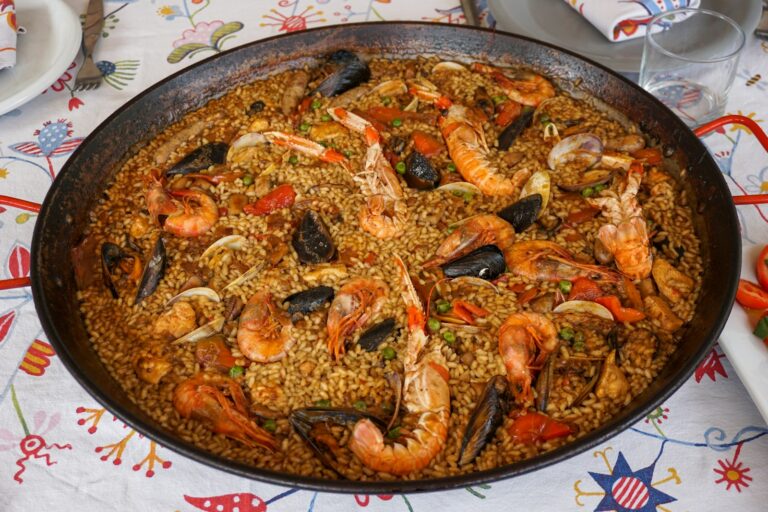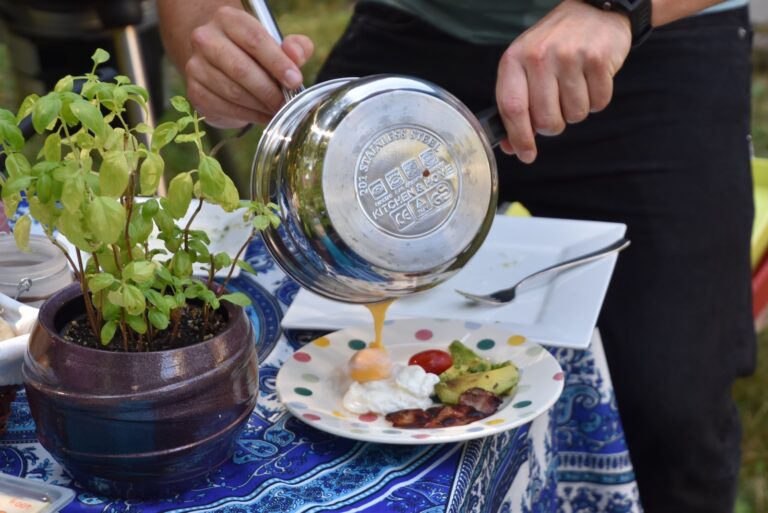I’ve always wondered if you really need a special pan for making paella.
Well, turns out, the answer isn’t as straightforward as you might think.
In this article, I’ll explore the role of the paella pan in traditional Spanish cuisine and help you understand the unique design and features that make it stand out.
We’ll also discuss the benefits of using a specialized paella pan for that authentic, mouthwatering flavor.
So, let’s dive in and find out if a regular skillet can measure up or if the special pan is truly a necessity.
The Role of the Paella Pan in Traditional Spanish Cuisine
I love using my paella pan to cook traditional Spanish dishes. The paella pan plays a crucial role in the preparation of these flavorful meals.
Its wide and shallow design allows for the perfect distribution of heat, ensuring that the rice cooks evenly and develops that irresistible socarrat crust.
The pan’s material is also of great importance in paella cooking. Traditionally, paella pans are made of carbon steel, which provides excellent heat conductivity and retention. This allows for the rice to cook evenly and absorb all the delicious flavors of the ingredients. Additionally, the carbon steel pan develops a natural non-stick coating over time, enhancing the cooking experience.
However, other materials like stainless steel or enamel can also be used, although they may not provide the same authentic taste and texture.
Overall, the paella pan is an essential tool in creating the perfect traditional Spanish dishes.
Understanding the Unique Design and Features of a Paella Pan
The unique design and features of a paella pan make it essential for creating an authentic and delicious paella dish. When it comes to understanding paella pan materials, there are a few key things to keep in mind.
Firstly, traditional paella pans are made of carbon steel, which allows for even heat distribution and excellent heat retention. This ensures that your paella cooks evenly and develops that irresistible socarrat, the crispy layer at the bottom.
Secondly, the wide, shallow shape of the pan allows the rice to cook evenly and absorb all the flavors of the ingredients.
Cleaning and maintaining your paella pan is also crucial for its longevity. To keep your pan in great condition, avoid using harsh detergents or abrasive sponges. Instead, clean it gently with warm water and a soft cloth. After washing, make sure to dry it thoroughly to prevent rust.
Benefits of Using a Specialized Paella Pan for Authentic Flavors
Using a specialized pan ensures that the flavors in my paella are authentic and delicious. There are several advantages to using a specialized paella pan for traditional cooking.
Firstly, the pan’s wide, shallow design allows for even heat distribution, ensuring that all the ingredients are cooked perfectly. This is important because paella requires precise cooking times for each ingredient to achieve the right flavors and textures.
Secondly, the pan’s large surface area allows for maximum contact between the ingredients and the pan, enhancing the caramelization process and creating a rich, flavorful socarrat, the crispy bottom layer of the paella.
Finally, the specialized pan’s handles make it easy to move and stir the ingredients, facilitating the traditional cooking technique of constantly moving the rice to prevent sticking and ensure even cooking.
Overall, using a specialized paella pan is essential for achieving the authentic flavors and textures that make this dish so special.
Alternatives to a Paella Pan: Can You Make Paella in a Regular Skillet
As a cook, I often wonder if a regular skillet can be used to make paella. While a specialized paella pan is ideal for this Spanish dish, there are alternative cooking methods that can be used with a regular skillet. However, it’s important to note that there are drawbacks to using a regular skillet for paella.
Here are some alternative cooking methods and their pros and cons:
- Oven method:
- Pros: Creates a crispy socarrat (caramelized crust) on the bottom.
- Cons: Lacks the traditional shallow shape of a paella pan, which affects the even distribution of heat.
- Stovetop method:
- Pros: Allows for better control over the cooking process.
- Cons: The regular skillet may not have the same capacity as a paella pan, affecting the amount of rice and ingredients that can be used.
Making an Informed Decision: Factors to Consider When Choosing a Paella Pan
When deciding on a paella pan, I consider factors such as size, material, and heat conductivity. These factors are crucial in making an informed decision and ensuring the best cooking experience. The size of the pan is important as it determines the amount of paella you can make at once. If you often cook for a large group, a bigger pan would be ideal. The material of the pan affects its durability and even heat distribution. Carbon steel pans are popular for their ability to develop a natural non-stick surface over time. Lastly, heat conductivity determines how evenly the pan heats up, leading to a perfectly cooked paella. By taking these factors into consideration, I can confidently choose a paella pan that suits my needs and guarantees delicious results every time.
| Factors to Consider | Making an Informed Decision |
|---|---|
| Size | Determine the amount of paella to be cooked at once |
| Material | Consider durability and even heat distribution |
| Heat Conductivity | Ensure even cooking for a perfect paella |
Conclusion
In conclusion, using a specialized paella pan is essential for achieving authentic flavors in traditional Spanish cuisine.
The unique design and features of a paella pan play a crucial role in evenly distributing heat and creating the signature socarrat, or crispy rice, that’s characteristic of a perfect paella.
While it’s possible to make paella in a regular skillet, investing in a specialized pan will enhance your cooking experience and help you create a truly delicious and authentic dish.

